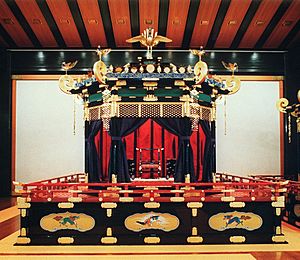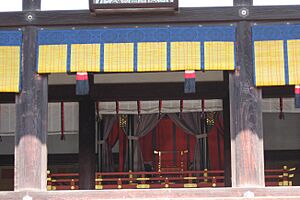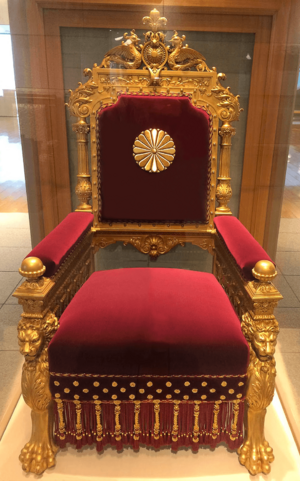Chrysanthemum Throne facts for kids

The Chrysanthemum Throne (皇位 (kōi, "imperial seat")) is the special throne used by the Emperor of Japan. It can also mean a specific chair, like the Takamikura (高御座) throne. This famous throne is found in the Shishin-den hall at the Kyoto Imperial Palace.
Other thrones or seats the Emperor uses for official events, like those in the Tokyo Imperial Palace, are not called the "Chrysanthemum Throne."
Sometimes, "Chrysanthemum Throne" is used to mean the head of state of Japan. It can also refer to the entire Japanese monarchy itself.
History of the Throne

Japan has the oldest continuous royal family in the world. The Chrysanthemum Throne is a symbol of the Emperor and the government's power. Before 1947, there was no clear difference between the Emperor's personal belongings and the country's property.
Legend says that Emperor Jimmu started the Japanese monarchy in 660 BC. Emperor Naruhito is the 126th ruler to sit on the Chrysanthemum Throne. Historical records only go back to Emperor Ōjin, who was the 15th emperor. He is thought to have ruled in the early 4th century.
In the 1920s, Crown Prince Hirohito acted as a regent. This was because his father, Emperor Taishō, was too sick to do his duties. However, the Prince Regent did not have the full power of the throne until his father passed away.
Today, the Constitution of Japan says the Emperor is "the symbol of the State and of the unity of the people." The modern Emperor is a constitutional monarch. This means the Emperor has a special role, but the government makes the laws. The term "Chrysanthemum Throne" now includes the modern royal family and all the emperors, both legendary and historical.
The Takamikura Throne
The actual Takamikura (error: {{nihongo}}: Japanese or romaji text required (help)) throne is in the Kyoto Imperial Palace. It is the oldest throne still used by the Japanese royal family. The current version was built for Emperor Taisho's enthronement ceremony in 1912.
The throne sits on an eight-sided platform, about 5 meters (16 feet) above the floor. A special curtain separates it from the rest of the room. A sliding door, called the kenjō no shōji (error: {{nihongo}}: Japanese or romaji text required (help)), hides the Emperor from view. This door has paintings of 32 heavenly saints. These paintings became a main example for art during the Heian period.
The Takamikura throne is mainly used for the enthronement ceremony. It is used along with the michodai (error: {{nihongo}}: Japanese or romaji text required (help)), which is the special seat for the Empress.
For the enthronement ceremonies of Emperors Akihito and Naruhito, both the Takamikura and Michodai thrones were taken apart. They were then fixed up and put back together at the Seiden State Hall in the Imperial Palace in Tokyo. This is where the ceremonies are now held.
Emperor's Throne in Parliament
The emperor's throne used in parliament is a Western-style chair. It was used in the House of Peers from 1868 to 1912. The Emperor still uses this throne during ceremonies of the National Diet (Japan's parliament). He uses it for non-political speeches.
For example, the Emperor uses the throne during the Speech from the Throne ceremony. This happens in the House of Councillors. This ceremony opens regular Diet sessions each January and after elections. It also opens extra sessions, usually in autumn.
This throne is made with real gold. It has special details like the 16-petal chrysanthemum seal. It also features two lion heads, two phoenixes, and the sun disc.
See also
 In Spanish: Trono del Crisantemo para niños
In Spanish: Trono del Crisantemo para niños
- Order of the Chrysanthemum
- List of Emperors of Japan
- Imperial Regalia of Japan
- National seals of Japan
- Imperial House of Japan
- National emblem
- Dragon Throne of the Emperors of China
- Throne of England and the Kings of England
- Phoenix Throne of the Kings of Korea
- Lion Throne of the Dalai Lama of Tibet
- Peacock Throne of the Mughal Empire (India)
- Sun Throne of the Persian Empire and Iran
- Silver Throne – the Throne of Sweden
- The Lion Throne of Myanmar



